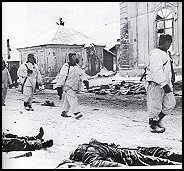 Soviet infantry pass dead Germans |
- Project 60: A Day-by-Day Diary of WWII - Remembering the First Fight Against Fascism |
 British Matilda tanks advance against German positions in North Africa |
 Soviet infantry pass dead Germans |
- Project 60: A Day-by-Day Diary of WWII - Remembering the First Fight Against Fascism |
 British Matilda tanks advance against German positions in North Africa |
|
This Week 1941 Archives Hot Links: East Front Aug-Dec '41 | North Africa Nov 41-July 43 November 18, 1941 Geuderian, commits additional 2nd Panzer Army forces to recover ground lost yesterday when his 112th Infantry Division panicked and broke. The new attacks captured Epifan and Dedilovo south of Moscow. Seven Commonwealth divisions of the newly formed British 8th
Army begin Operation Crusader. The goal of the offensive is to relieve the
garrison at Tobruk and drive the Africa Korp into western Libya. The British 7th
Armored Division “The Desert Rats”, advances 30 miles behind the enemy lines
meeting scattered and light resistance from the Germans. November 19, 1941 Frustrated by his army's slow advance, General Hopner (3rd Panzer Army) commits the last of his reseves in the Kalinin area. Caught by surprise, the Germans misread the British intent
and think that the enemy is attempting to encircle Bardia and send the bulk of
the Africa Korp deeper into the trap. November 20, 1941 Third Panzer Army, after extremely heavy fighting, finally breaks the stubborn Soviet resistance in the Kalinin area and advances 20 kilometers. The British order the Tobruk garrison to break out and link
up with XXX Corp. Rommel, back from his visit to Rome, turns the Africa Korp
back to the west to meet the real threat and orders an attack at Sidi Rezegh. The Italian ships Trieste and Luigi, while escorting an
Axis convoy are torpedoed November 21, 1941 The 3rd Panzer Corp (1st Panzer Army) captures
Rostov. Albert Speer, in a meeting with Hitler, requested that he
be assigned 30,000 Soviet prisoners to be assigned to force labor parties to
build the “new Berlin”. After seeing Speers models of the Great Hall and the
Office for Goering, Hitler readily agreed. November 22, 1941 The battle at Sidi Rezegh continues. British tank losses
force the British XXX Corp to order an end to their advance on Tobruk. The
garrison at Tobruk is also ordered back to their defensive positions. VIII Corp
is able to take Sidi Omar and Capuzzo to the east. Secretary of State
Hull hinted that there might be relaxation of economic pressures on Japan saying
that, “… there was a general feeling that the matter could all be settled if
the Japanese could give us some satisfactory evidences that their intentions
were peaceful." As starvation
begins to set in at Leningrad, the first attempt to cross the recently frozen
Lake Ladoga is made. 33 tons of flour arrive in the besieged city. “Operation Z”
commences as the Japanese begin secretly assemble all six of their major
aircraft carriers at Tankan Bay in the Kurile Islands for the attack on Pearl
Harbor. November 23, 1941 The 7th Panzer Division (56 Panzer Corp, 3rd Panzer Army) captures the key road junction of Klin northwest of Moscow. Zhukov orders a limited withdrawal of the 5th and 16th Army's which is executed in good order despite the German pressure. German forces, facing ever-stiffening resistance are still
advancing and are 35 miles northwest of Moscow. November 24, 1941 Rommel launches an attack to the Lybian-Egyptian Border. The US Army issues a war warning, indicating that there is
a strong possibility of war. The United States,
with the agreement and consent of The Netherlands and Brazil, occupies Dutch
Guiana (Surinam) securing the bauxite mines which furnish nearly 60 percent of
the United States needs for the aluminum industry. Those wishing to contribute items. stories or comments should contact D.A. Friedrichs |
Editor's Corner The items found in this section are comments from the editors of Project 60 and may not necessarily reflect the opinions of bartcop. an excerpt from "Want to Win" ... .... If we are serious about taking the war to the enemy, it is time to look to history for some indication of how this war should be fought. History is littered with the cases of how to conduct, and more importantly how not to conduct this type of fight. Terrorism is simply the first stage in the evolution of guerilla war. Mao Tse Tung, arguably the most successful of modern practitioners of “irregular warfare”, describes in his writings the stages of a successful guerrilla war. Guerilla war has its genesis in discontent. A body of people see themselves as being repressed, disrespected, and trod upon. The natural reaction is to strike back. However, those who are seen to repress others are typically too powerful to take on directly. This discontent spawns small groups of people who take action against their enemy. In essence this is what we call terrorism today. These fanatics (their friends call them freedom fighters) come together to create havoc and inflict pain on those who allegedly repress or insult their people. This leads to reprisals and the discontent from those reactions create the fertile fields where masses of recruits can be harvested..... Previous Columns Want to Win - Think Before You Lash Out - "If we are serious about taking the war to the enemy, it is time to look ..." The First Fight Against Fascism - We must remember the Spanish Civil War also. Arguing Victory - "... Each nation who fought against fascist tyranny in WWII brought with it part of whole needed to defeat that evil..." War, Glory, Honor and Remembrance - "War is a brutal and savage insult on human society..." The
First Casualty... in time of war, those in power are even more inclined to hide the truth,
since that truth is often manifest in the most gruesome and terrible
acts. |